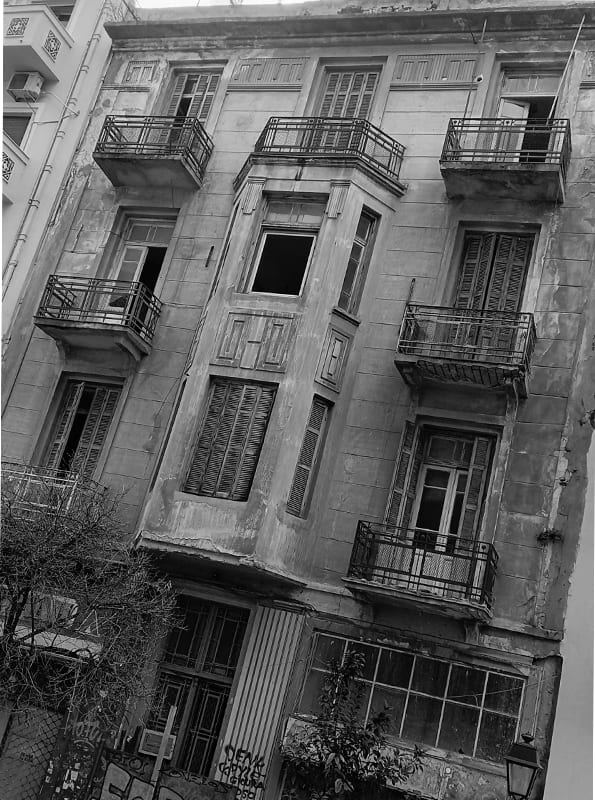72 Tsimiski Street
Choked by exhaust fumes and modern apartment buildings. They stand next to us against time and decay. We pass them by, we don’t notice them, in some of them we live and work, do our shopping or drink a coffee. Others wither away from our indifference. Living and proud symbols of the city’s history, they hide important events, dark secrets, family stories, tragedies and joys.
Description

Neoclassical, listed, European eclecticism, classicism, baroque, modern, these are the buildings that are symbols of the city. A remarkable eclectic building with Art Deco elements. The central axis of the facade from the level of the 2nd floor to the level of the 4th floor, protrudes creating a vertical three-sided bay window with openings that are integrated into each of its three individual facades. Of interest are the individual decorative elements, such as the balustrades of the balconies, the decorative linear elements that surround the openings, the pediments, the high openings with skylights, etc. It forms a whole with the neighboring building on 74 Tsimiski Street. The building inside preserves the iron entrance door, plaster decorations on the ceilings, wooden frames, and the configuration of the entrance area.
A place of torture and pain
Another beautiful and unique building in the city center, the memory of one of the most horrific torture centers of the occupation, according to testimonies, was preserved.
Morphologically, it dates back to the decade 1925-1935 and is one of the most historic buildings in our city. During the Occupation, the German Secret Military Police (GFP) was commandeered and housed here. The commander of the service was Szykowski and the interrogator was Max Kerbes. Inside this building, dozens of Thessaloniki residents were interrogated, tortured and even died. On the 4th floor was the “interrogation room” and in the basement the detention facilities. After the liberation, dozens of stories of people who passed through the building and were lucky were revealed.

The German Secret Military Police (GFP) was headquartered in the Tsimiski building at number 72, whose strength, after 1943, amounted to 170-180 people, most of whom had served in the German and Austrian police before the war. The 1st Office of the GFP, which was housed in the “Bosporion Megaron”, at 6 Aristotelous Street and was responsible for confronting and neutralizing any resistance action and mainly protecting the occupation army from sabotage, theft and espionage, but also combating the rebels while simultaneously neutralizing their supply networks.

It was a literal hell, where hundreds of Thessaloniki residents were tortured during the three and a half years of German Occupation, with many of them never coming out alive after what they suffered at the hands of their executioners. And just hearing the address “72 Tsimiski Street”, everyone froze and wished they would never have to enter the building, as the service housed there had quickly become synonymous with the words terror, misery, torture, pain..
A terrifying testimony
The revelations that came to light in the first months of liberation included the testimony of Petros Kontoudis from Thessaloniki. He was “fortunate” to experience firsthand what was happening in the building at 72 Tsimiski Street, but also in “510”, where he was subsequently transferred, and also in the Hitler camps of Auschwitz, Birgenau and Buchenwald, where he was sent to continue his… studies in the methods of the Hitlerite beast.
The revelations about the hellish conditions that Hitler’s executioners had created in the torture chambers of Thessaloniki were devastating in the early days of liberation and before the turmoil of civil war broke out.
In fact, as the local newspapers of the city wrote in the first months of 1945, “whole volumes will one day be occupied by the narrative of the horrible crimes committed in our country by the Germans during the dark period of the Occupation. A book necessary for even the last Greek of future generations to learn the untold drama of our race and to become informed about the mental dispositions of the “civilized” German nation.”
